- 2025 second half of the year CEO Compliance Message -
CEO, Samsung Heavy Industries Sung-an Choi
Samsung Heavy Industries seeks to drive its operations primarily through the Board as the organization that sets business objectives and executes strategies that enhance corporate and shareholder value. Roles and responsibilities of the Board are specified in the Articles of Incorporation and Board Regulations to ensure the Board's effective function as the highest decision making body of the company. The Board is efficiently performing its functions through direct execution of authority and appropriate delegation and we will continue to manage the company through reasonable and transparent management decisions centered on the board of directors.
* More information about the Board of Directors can be found in the Corporate Governance Report within the Data Center-Report.
Samsung Heavy Industries systematically manages candidates for stable CEO succession through the 'Core Post Succession Plan', a process for CEO succession. Based on the competency of the candidate, the candidate group is divided into the 'Ready Now' group that can be active immediately and the 'Ready Later' group that is expected to be active within the next few years, and each group is updated and managed every year. we select and manage candidates for considering various items such as leadership required as a CEO and understanding of our business industry.
Samsung Heavy Industries stipulates that the number of directors constituting the Board of directors is between three and eight, and as of 2023, it is composed of a total of seven directors (three Executive Directors and four Independent Directors). Among them, Independent Directors consist of four (57.1%) that meets the Commercial Law that requires more than three Independent Directors for listed companies with more than two trillion assets. In addition, all members of Committees except for the Management Committee were appointed as independent directors to strengthen the supervision and check functions of management.
| Executive | Independent | ||||||
|---|---|---|---|---|---|---|---|
| Name | Sung-an Choi | Wang-geun Lee | Kyung-hee Kim | Hyun-wook Cho | Sang-jik Yoon | Won-jae Lee | Sang-gyu Kim |
| Date of Appointment | March, 2023 | March, 2024 | March, 2025 | March, 2020 | March, 2024 | March, 2024 | March, 2025 |
| Date of Term Expiry | March, 2026 | March, 2027 | March, 2028 | March, 2026 | March, 2027 | March, 2027 | March, 2028 |
| Board of Directors | ● | ○ | ○ | ○ | ○ | ○ | ○ |
| Audit Committee | ● | ○ | ○ | ||||
| Management Committee | ● | ○ | ○ | ||||
| Independent Director Recommendation Committee | ● | ○ | ○ | ||||
| Internal Transaction Committee | ○ | ● | ○ | ||||
| Compensation Committee | ● | ○ | ○ | ||||
| ESG Committee | ● | ○ | ○ | ○ | |||
Samsung Heavy Industries appoints Directors by approval at the general meeting of shareholders to ensure that the Board through a fair process can faithfully fulfill its duty for all shareholders.
Executive Directors systematically manage the candidates for CEO through the "Core Post Succession Plan," and based on this, the board of directors selects candidates through in-depth review by comprehensively considering the company's situation, experience, and internal and external conditions.
Independent Directors are focused on securing independence by appointing them among those recommended by the Independent Director Recommendation Committee. In particular, through the Articles of Incorporation, the requirements for exclusion of qualifications for the appointment of Independent Directors are complied with, and if they fall under this after the appointment of Independent Directors, they are required to lose their position. In addition, as a verification procedure for appointing Independent Directors who can perform their duties in an objective and independent position, we use a checklist for Independent Directors qualifications. We send a checklist to candidates recommended by the Independent Directors Recommendation Committee to check whether it is applicable or not, and we are doing our best to cross-check the business relationship with the company to appoint them who have no interest in the company as Independent Directors.
From September to October every year, CEO and HR senior executives are responsible for evaluating Independent Directors and the results are used to determine re-election or replacement at the end of their tenure. It consists of various items such as the activity performance, management contribution, and expertise of individual directors. The evaluation is based on individual performance such as committee activities and review performance for agenda to ensure fairness.
SHI is dedicated to fostering a culture of compliance and to incorporatin compliance into core business fundamentals.
With the Code of Conduct at the heart of our business practice. SHI encourages all the executives and employees to align with this mission and set clear standards for ethical conduct.
- 2025 second half of the year CEO Compliance Message -
CEO, Samsung Heavy Industries Sung-an Choi
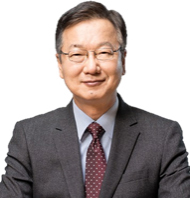
"When you abandon the law and principle for shot-term profit, you abandon yourself and complany's future. "
First, Employees shall conduct their business activities in compliance with all applicable laws and regulations by understanding the importance of compliance in business.
Second, Employees shall not make any decisions or engage in any activities that would compromise ethical standards.
Third, Employees shall be committed to maintaining the highest level of integrity and ethical standards by participating in the company's Compliance Program.
Based on a strong commitment from senior management and the Board, SHI has successfully integrated the value of compliance into standard operating procedures. SHI proactively manages compliance risks through effective management of the Compliance Program, while SHI also strives to promote a culture of compliance through a series of trainings and events.


| Compliance control standards |
It is a company regulation that sets standards and procedures for compliance control that employees should follow when performing their duties to prevent violations of the law during work. Compliance control standards Download (PDF) |
|---|---|
| Anti-Corruption Pollicy and Procedure |
It is established to promote a sound and sustainable development by ensuring that all executives and employees abide by the anti-corruption laws. Anti-Corruption Compliance Policy and Procedures Download (PDF) |
| Compliance Guideline for Business Partners |
It is established to communicate SHI's compliance standards and procedures by outlining a set of rules expected from third parties. Compliance Guideline for Business Partners (Video) |
Samsung Heavy Industries has established the Compliance Program to meet up to the rapidly changing expectations and to ensure that all executives and employees abide by laws and regulations in daily activities. The risks of misconducts are proactively managed through well-designed Compliance Programs comprised of prevention, review and monitoring, and follow-up management. SHI identifies and proactively manages compliance risks in all of its business areas by implementing compliance standards into all the affiliates and subsidiaries around the world. In addition, SHI runs a risk analysis regularly by identifying the possible compliance risks that the company faces and reviewing areas of improvement. Further more, SHI strives to raise employee awareness towards the Compliance Program through the Standard Compliance Agreement and continuous improvements.
Activities to prevent misconduct during the course of business operation and daily practice.
Monitoring and identifying non-compliance/risk of violations with laws and internal policy on an ongoing basis.
Correcting violations and complementing compliance programs
Samsung Heavy Industries runs a Compliance Committee that oversees the company's Compliance Program. The Compliance Committee consists of the CEO (Chair), CCO (Secretary) and other employees holding senior position within the company. A regular meeting is convened semi-annually to receive reports on performance, and the Committee sets the direction of the company's Compliance Program.
Samsung Heavy Industries incorporates its compliance program into functional areas through individual employees designated as "Compliance Performers," who take on compliance-related responsibilities on top of their other job duties. These Compliance Performers include CL (Compliance Leader), CM (Compliance Manager), and CA (Compliance Assistant). Compliance Leaders supervise the compliance activities of their respective teams and/or divisions, conduct monthly trainings, identify risks, and make recommendations to the Compliance Team.
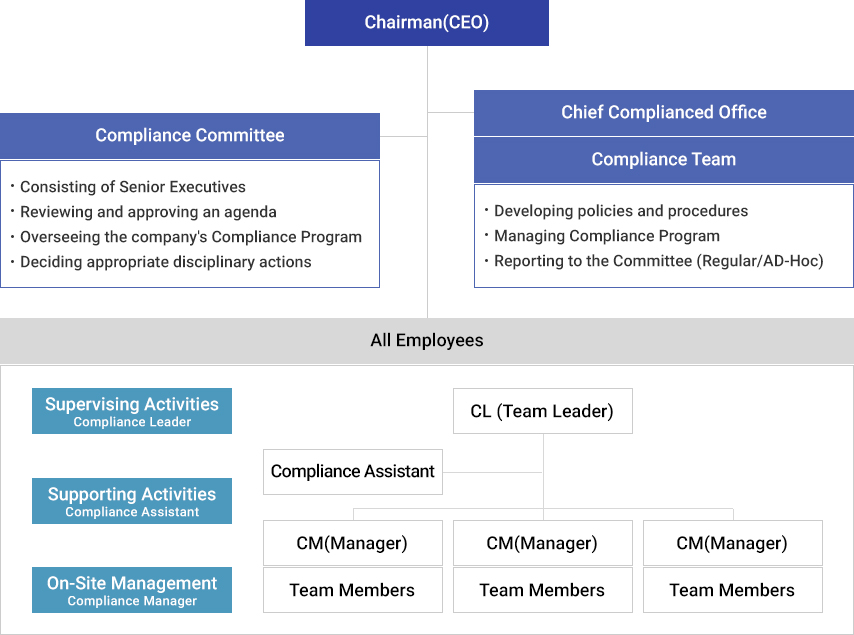
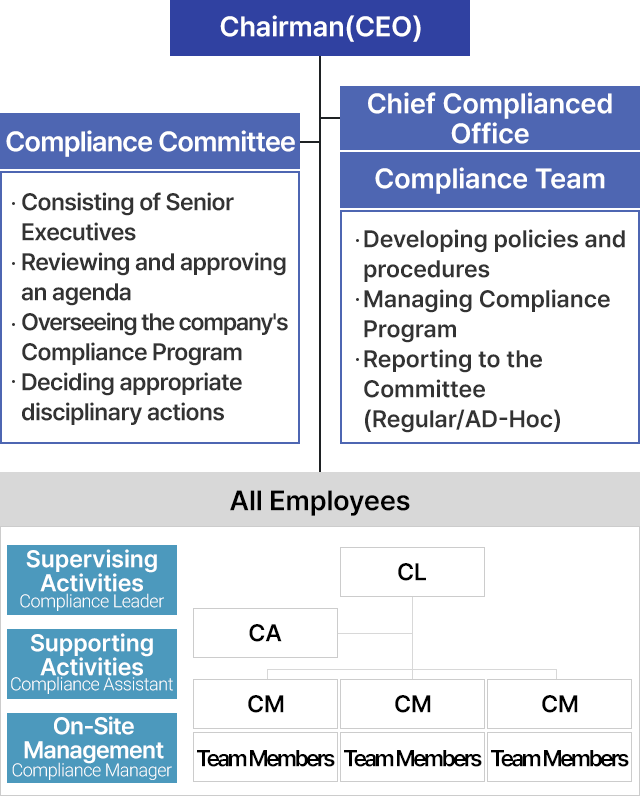
Every year, Samsung Heavy Industries conducts an internal risk assessment as part of its annual Compliance Program planning. The result of the risk assessment is incorporated into and applied to the company's compliance control system.
Every year, all employees of Samsung Heavy Industries are required to represent that they will comply with all applicable laws and regulations by understanding the importance of compliance management.
Samsung Heavy Industries includes compliance provisions in contracts with all third parties. These provisions include the requirement of compliance with anti-corruption.
SHI provides effective and systematic compliance training so that its employees can prevent and respond to risks they may face while performing their jobs. We organize training for all employees according to the annual training plan, and to increase the effectiveness of training, we conduct training by rank or job accordingto theme. All employees are required to take basic trainings, while higher-risk departments and employees involved in higher-risk projects are required to take intensive trainings as well. In addition, whenever a group of employees requests supplemental training from the Compliance Team, compliance experts visit the group to provide tailor-made trainings.
| Division | Target | Curriculum | |
|---|---|---|---|
| Basic | By Job Grades | All Employee | Compliance Overview, Ethics, Sexual harassment |
| Senior Management | Tailored Compliance Training | ||
| Newly Promoted Managers | Compliance Overview | ||
| New Recruits | Compliance Overview | ||
| Expatriate | Compliance Overview | ||
| Higer-risk Teams | Sales | Anti-Corruption, Anti-Cartel | |
| Procurement / Production / Engineering | Mutual cooperation(Subcontracting) | ||
| Personal Data Processing Team | Personal Data Protection | ||
| Intensive | Special Trainings | Relevant Employees | Specific Theme |
| Requested by Employees | Team requesting a training | Requested by Employees | |
| Supplemental | Compliance Team Member | External Seminar and Conference | |
Samsung Heavy Industries has built an effective risk and compliance screening system(CP EYES) that enables us to identify potential risks in advance. Where red flags are identified, the Compliance Team notifies relevant departments of such red flags and conducts enhanced due diligence on higher-risk areas.
Samsung Heavy Industries has implemented a variety of internal controls related to anti-corruption compliance. The reimbursement of expenses as well as charitable contributions are monitored to ensure compliance with all applicable laws and regulations.
Every year, the Compliance Team conducts an internal Offline risk assessment as part of its annual Compliance Program planning. The Compliance Team develops compliance policies and procedures on the basis of periodic risk assessments addressing the individual circumstances of the company and reports results to the Compliance Committee and/or the Board of Directors.
In principle, Samsung Heavy Industries prohibits employees from meeting with competitors. However, in cases where meeting is inevitable such as at trade fairs, all employees are required to register such information on SHI's Anti-Cartel Compliance system. The Compliance Team manages and minimizes cartel-related risks by requiring employees to report subject of contact, schedule and purpose of the meeting and by providing precautionary information to relevant employees in advance.
Samsung Heavy Industries maintains a whistleblowing reporting channel, which is accessible to employees as well as the general public (including third parties). Reports may be made through online(e-mail, mobile, fax, internet homepage, etc.) and offline channels (compliance postbox, etc.). The Compliance Team protocols specify that reports can be made confidentially and that whistleblowers will not be subject to retaliation for making a disclosure.

Samsung Heavy Industries implements rigorous controls for its business marketing process. Specifically, the Marketing Team is required to perform compliance checks,
provide compliance-related information to the Compliance Team and other committees, and obtain approvals at multiple stages of the contracting processes. Where red flags are identified,
enhanced due diligence shall be performed.
Lastly, the process requires the participation of numerous corporate functions, including the accounting team, which monitors all commission payments for conformity to performance of
contracts.
Samsung Heavy Industries specifically refers to the need for due diligence on and ongoing monitoring of third parties including commercial agents, subcontractors, and vendors.
Every third party is required to complete a compliance questionnaire as well as certification of anti-corruption compliance, and Samsung Heavy Industries makes use of outside specialist
firms in conducting background research. If red flags are identified in the process, risks should be addressed and resolved prior to contracting.
On higher-risk third parties, Samsung Heavy Industries conducts in-depth review as well as enhanced due diligence. Pursuant to the Anti-Corruption Compliance Policy and Procedures,
Samsung Heavy Industries conducts due diligence on business partners prior to contracting. Enhanced due diligence is required for higher-risk agents and partners.
Due Dilligence Process
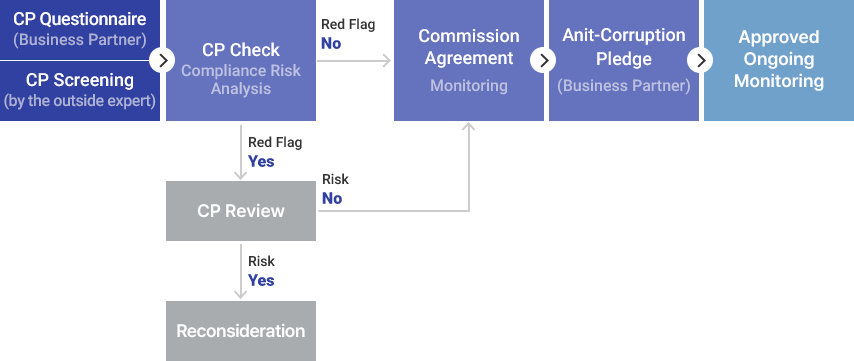
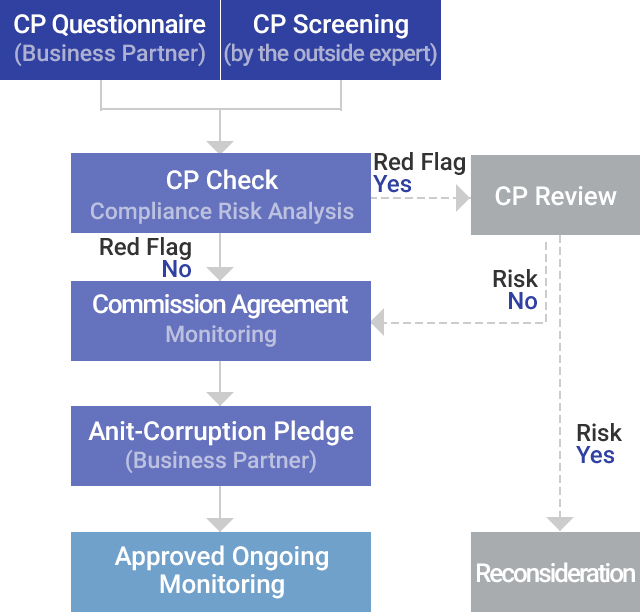
Every month, Samsung Heavy Industries publishes and distributes a Compliance Newsletter to all employees. Compliance Newsletter contributes to promoting a culture of compliance throughout the company by notifying employees of compliance updates and other relevant information.
Since 2015, the Compliance Team has hosted "Compliance Day" every third Tuesday. On "Compliance Day", all teams conduct compliance trainings, risk assessments and surveys, and hold a variety of events on a monthly theme, leading to enhancement of compliance-related knowledge and awareness.
To promote a culture of compliance, Samsung Heavy Industries has implemented mechanisms for incentivizing compliance with its policy and procedures. Annually, "Best Practice Awards" and "Compliance Awards" are providedfor exemplary compliance leadership and publicized within the company.
Since 2015, an annual average of 2,000 cases are reviewed, and the Compliance Team has been providing practical assistance to employees as well as promoting a culture of compliance.
Please find below a list of numbers connected to the whistleblowing hotline
The contents of the report and all informations related to whistleblower will be kept strictly confidential and will not incur any disadvantage to the whistleblower in accordance with our regulations.
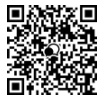
Samsung Heavy Industries aims to be the global No.1 company through fair and transparent corporate management
under the philosophy of "We devote our human resources and technology
to create superior products and services, there by contributing to better global society".
We set this SHI Ethical Constitution as basis of our practices and value judgment under the belief that global
No.1 corporation with world wide respect and trust only when we pursue new technologies and higher quality in a
single mind and direction, based on sound corporate ethical standard and clean organizational culture.
Samsung Heavy Industries responds to financial and non-financial risks for stable and sustainable growth by managing various risks arising from the rapidly changing business environment.
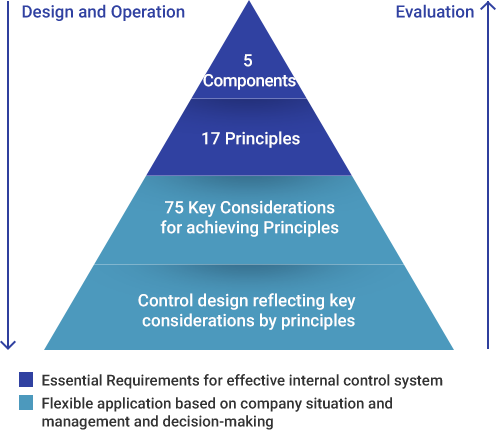
Risks derived
Control design
Simulation test
Complementation and application
| Division | Background | Impact | SHI's Response |
|---|---|---|---|
|
Energy conversion |
Paradigm shift in energy market from traditional energy sources to eco-friendly and low-carbon energy sources | Possibility for business structure change caused by paradigm shift of energy market |
|
|
Environmental issues |
Recognition of the value and importance of solving environmental issues such as climate change, waste disposal, and water shortage | Increased risks and opportunities for increased environmental regulations/costs |
|
|
Fourth Industrial Revolution |
With the advent of the 4th industrial technology, innovation in the business environment and production method is required through digitalization, visualization, automation, and intelligence | Increased market liquidity due to intensifying competition for new technology development |
|
|
Infectious disease |
Unpredictable changes in global politics, economy, industry as a global pandemic including COVID-19 | Increased financial risks from business continuity and economic recession |
|
|
Ethics and compliance |
Strengthen corporate ethical and social responsibility and increase corporate management with transparency | Strengthening systems related to human rights and corporate social responsibility |
|
|
Safety/Security |
Regonition change of industrial accidents and Increase the importance of safety | Strengthening laws and regulations related to the prevention of serious and industrial accidents and increasing the level of safety requirements of customers |
|
|
Supply chain |
Increasing importance of stable supply chain and quality management | Increasing the need for win-win management |
|




